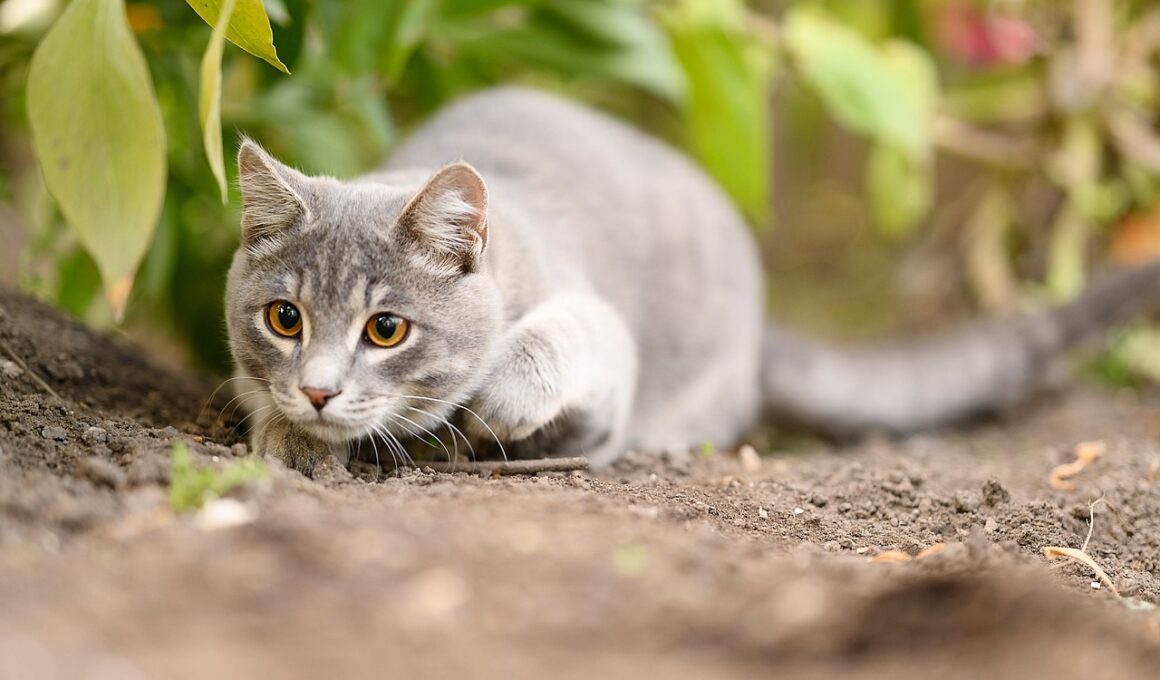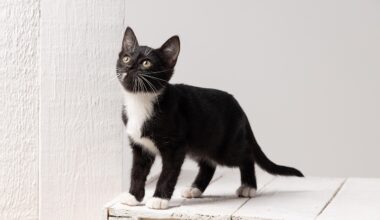How Seasonal Changes Affect Problematic Hunting Behaviors in Cats
Understanding problematic hunting behaviors in cats is essential for pet owners, especially as seasonal changes can significantly influence these behaviors. As the seasons shift, cats may experience increased energy levels, which can lead them to engage in hunting activities more frequently. This increase in activity can be particularly noticeable during spring and fall, when natural prey species are more abundant, prompting cats to attempt to hunt more often. Owners might observe their pets pouncing on imagined prey or chasing shadows around the house, all driven by this seasonal instinct. Additionally, with longer daylight hours in spring and summer, cats are likely to exhibit heightened arousal and playfulness. Consequently, for cat owners, it is crucial to understand these seasonal changes to mitigate any destructive hunting behaviors that might arise at home. For example, providing appropriate toys or playtime can redirect a cat’s hunting talents away from household items. In doing so, pet owners encourage healthy behaviors while ensuring their feline companions remain engaged and happy throughout each season. Regularly monitoring these changes enables better behavioral understanding and encourages more effective strategies to manage problematic actions.
Moreover, changes in weather conditions during different seasons can impact outdoor and indoor hunting behaviors of cats. When it’s hot and humid, cats may choose to stay indoors and entertain themselves with interactive toys or climbing structures. On the other hand, during cooler months, they might feel energized and more inclined to explore their territories outside, leading to varied hunting behaviors. This difference can present challenges for owners, especially if the cat exhibits unwanted stalking or pouncing on household items when they feel cooped up indoors. It’s crucial for owners to recognize that excessive indoor hunting could be a physical expression of frustration or boredom. By establishing routines that provide mental and physical stimulation in line with the season, cat owners can effectively minimize such problematic behaviors. Providing options like moving objects or laser pointers simulates the hunt, allowing cats to exercise their instincts without resorting to destructive actions. Therefore, understanding these seasonal cues can lead to better pet management, ensuring that behavioral issues are addressed proactively instead of reactively. Owners who can adapt their approach based on weather can enjoy a more harmonious household with their feline companions.
The Role of Prey Availability
Another crucial factor that affects problematic hunting behaviors in cats is the availability of prey in their environment. During specific seasons, natural prey like rodents and birds become more active and accessible. As the natural hunting instincts of cats are triggered by the presence of these animals, owners may find their pets exhibiting increased hunting-related behaviors. This can lead to problematic scenarios, such as cats attempting to hunt down small animals in gardens or near windows. It’s essential for owners to understand that this behavior is normal and deeply rooted in their feline instincts. One approach to manage this issue involves increasing indoor stimulation to distract cats from feeling the urge to hunt outdoors. Providing puzzle toys or engaging play sessions can channel their energy and predatory instincts in a controlled manner. Additionally, cat owners should consider creating a secure outdoor space, like a catio, where their pets can safely enjoy the sights and sounds of nature without potential harm. This alternative allows cats to experience the outdoors while preventing wildlife predation, hence preserving the balance between a cat’s instincts and responsible pet ownership.
In terms of managing problematic hunting behaviors during seasonal changes, cat owners should also be aware of how their pets might react to different stimuli. Urban cats or those living in busy households may develop specific behavioral patterns when faced with seasonal changes, such as increased aggression or heightened anxiety when they sense other animals nearby. To mitigate such stressors, owners might implement feline-friendly solutions like creating vertical spaces for climbing, which provide safe escape routes when they feel threatened. Cat trees or shelves can facilitate exploration and create opportunities for playful interaction rather than stalking behaviors. These strategies support a cat’s need for space and can help alleviate feelings of defensiveness or frustration, which often manifest as aggressive hunting behaviors. Furthermore, ensuring a diverse environment with varied toys will keep a cat stimulated and less likely to engage in problematic hunting. Situational awareness and understanding each cat’s unique temperament can guide owners in developing tailored strategies, ensuring their pets remain content and well-adjusted throughout seasonal transitions.
Behavioral Training Techniques
Implementing effective behavioral training techniques can also help address problematic hunting behaviors in cats influenced by seasonal changes. Many cats respond well to positive reinforcement training methods, which can be particularly useful during times of increased activity. Encouraging desirable behaviors through rewards such as treats or praise can redirect their energy from hunting-related activities to more appropriate play. Training sessions can be structured around times when cats are more active, allowing owners to capitalize on their natural instincts by incorporating playtime as part of their routine. In addition to traditional training methods, using clicker training can capture the cat’s attention, offering instant feedback that reinforces good behavior. This approach allows owners to actively participate in their cat’s behavioral improvement. By reinforcing calm or non-hunting actions, owners can gradually reduce problematic behaviors without punishments. Engaging cats in interactive play that satisfies their hunting instincts while prioritizing safe environments fosters a positive atmosphere for both the cat and their human companions. This balance between play and training promotes healthy lifestyle habits over time, maintaining well-adjusted pets regardless of the changing seasons.
As part of dealing with problematic hunting behaviors, owners should also consider environmental enrichment that enhances their cats’ engagement. Seasonal changes can spur curiosity, leading cats to seek new ways to fulfill their natural instincts. Regularly introducing new toys or activities aligned with different seasons can pique their interest and curb negative behaviors. For instance, using seasonal scents or catnip can stimulate exploratory behavior, making playtime more enjoyable and fulfilling for cats. By diversifying their toys and stimulation options based on seasonal moods, owners can help manage unwanted hunting tendencies caused by boredom or overstimulation. Additionally, observing your cat’s behavioral patterns during various times of the year can provide insights into their activity levels and emotional states. Through consistent effort and adaptation, the relationship between the cat’s instincts and their environment can flourish. This conscious approach allows owners to foster healthier habits that respect their cats’ natural instincts while preventing problematic behaviors. In conclusion, creating a supportive and enriching environment aligned with seasonal changes plays a vital role in managing hunting habits.
Conclusion
In conclusion, understanding how seasonal changes impact problematic hunting behaviors in cats is essential for owners seeking a harmonious relationship with their pets. Recognizing the natural instincts that drive these behaviors can help in managing and redirecting them constructively. With proactive approaches, such as enhanced indoor stimulation, structured training, and environmental enrichment, owners can effectively minimize instances of unwanted hunting. It’s about harnessing their natural behaviors in a way that doesn’t disrupt the household or harm other inhabitants, whether animal or human. By observing and adapting to their cat’s needs through the seasons, pet owners can nurture a more fulfilling and content existence for their feline companions. Ultimately, cultivating a deeper understanding of these shifts helps build a stronger bond between cats and their owners. Thus, ensuring an overall enjoyable experience comes from recognizing these changes and providing appropriate outlets for feline instincts without infringing on their need for essential stimulation. Embracing this knowledge will undoubtedly ease the journey toward a peaceful cohabitation for both cats and their caretakers.
Furthermore, regular veterinary check-ups are crucial in observing any underlying health concerns that may affect a cat’s behavior during different seasons. Seasonal allergies, changes in metabolism, or stress factors might exacerbate aggressive or problematic behaviors. It is essential to monitor physical and emotional health as part of responsible pet ownership. Understanding when certain behavioral problems may arise can allow owners to anticipate issues before they escalate. Careful observations during seasonal changes provide valuable information that can help tailor management strategies aimed at alleviating unwanted hunting behaviors. By fostering a supportive and attentive environment, owners create a space where their cats can thrive and express their natural instincts without turmoil. Additionally, it’s advisable for owners to keep an open dialogue with veterinarians or behavioral specialists when managing such behaviors, ensuring all bases are covered. This partnership enhances the likelihood of successful behavioral trends, ultimately benefiting both cats and their families. Consequently, enhancing your ability to adapt and respond to changes through proactive measures can keep your cat happy while ensuring they remain well-grounded. A comprehensive understanding of seasonal influences can empower cat owners to provide optimal care and enrichment for their pets.


